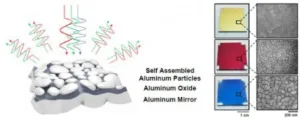Plasmonic technology has the potential to be integrated into reflective displays as the means to produce pixels that are extremely compact and that present a wide range of colors.

The colors produced using plasmonic technology are created by reflecting a narrow wavelength band of light from the broad spectrum found in ambient light. More specifically, in plasmonic technology as used in display applications, the color of the reflected light depends on the size, shape and pattern of reflective metallic nanostructures. (This is similar to the “organic” means sometimes used in nature to produce color. One example of this is the colors displayed by the wings of butterflies.)
The first advantage of the plasmonic technology approach is greater display energy efficiency as compared to current display technologies such as those that rely on LED backlights. A second advantage is reportedly the production of a more natural looking image than that produced by a conventional display.
Up to now, the use of plasmonic technology in displays has been limited by technical problems. Problems have included severe variation of the colors with viewing angle, insufficient saturation of the colors and difficulties in fabricating the necessary nanostructures over large areas. In addition, it has sometimes proven difficult to integrate plasmonic technology with the electronics used for active addressing. Finally, the approach is inherently unable to produce gray and black states.
Long time readers of Display Daily may recall a notable display development effort that included a switchable version of plasmonic technology. It was a device called iMoD developed by Iridigm Display Corporation. Iridigm was purchased by Qualcomm in 2004.
A team headed by Debashis Chanda within the NanoScience Technology Center at the University of Central Florida (Orlando, FL) have undertaken research to address the problems associated with plasmonic technology.
A recent article by the team is entitled “Self-assembled plasmonics for angle-independent structural color displays with actively addressed black states.” The article was published in Proceedings of the National Academy of Sciences, June 16, 2020 117 (24) 13350-13358. A copy is available on-line and can be found here.
The new approach can be explained by paraphrasing this technical article. A means was developed by which nanoparticles self-assemble in a quasi-random pattern on a pre-designed substrate. By exploiting the thin film growth mechanisms of aluminum during ultrahigh vacuum physical vapor deposition, dense arrays of particles can be created in near-field proximity to a mirror. The sub-10 nm gaps between adjacent particles and the mirror lead to strong multidimensional coupling of localized plasmonic modes. This, in turn, result in a singular resonance with negligible angular dispersion and about 98% absorption of incident light at a desired wavelength. The process is compatible with arbitrarily structured substrates and can produce waferscale, diffusive, angle independent and flexible plasmonic materials.
The researchers studied fabrication process parameters that included deposition rate, pressure and temperature. The goal was to develop means to control and optimize the process to create specific colors just by changing nanoparticle size.
The figure below and on the left illustrates self-assembled aluminum particles atop an oxide spacer and an aluminum mirror. The figure below and on the right contains camera and scanning electron microscope images of yellow, magenta and cyan surfaces. Note that the wavelength of the plasmon resonance scales with particle size.
Left: schematic of self-assembled aluminum particles atop an oxide spacer and an aluminum mirror. Right: camera and scanning electron microscope images of yellow, magenta and cyan surfaces demonstrating that the wavelength of plasmon resonance scales with particle size.
In their article, the researchers point out that producing black cannot be accomplished with plasmon technology but, rather, requires a different approach. To achieve a black state, the researchers decided to block the light scattered from the nanostructured surface by using a liquid crystal based technology. This was demonstrated by the researchers in their recent work by integrating plasmon based reflective pixels with otherwise conventional, actively addressed liquid crystal display components and construction. It was reported that the hybrid display prototype could successfully present fixed images and video.
In conclusion, the researcher explain that further development is required before displays using plasmonic nanostructures will be suitable for use in consumer products. None-the-less, the researchers opine that the results of the study are a significant step in that direction. -Arthur Berman
University of Central Florida, Debashis Chanda, [email protected]

